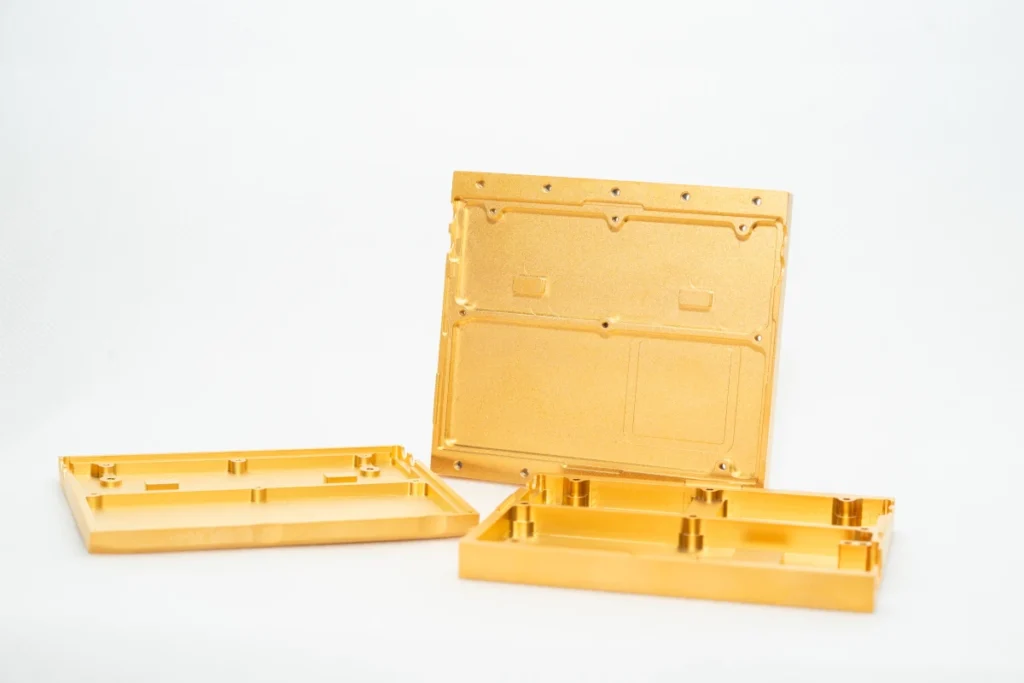The body is an element that rarely attracts attention, but without it, no system would function properly. It forms the structural base to which other parts are attached – from the smallest components to entire device modules.
In military applications, the tightness, strength, and stability of the entire system depend on the precision of the body’s manufacture.
At SIM Gdynia, we perform CNC machining and prepare bodies with complex geometries, which require not only high precision, but also experience and technological knowledge. Each of them is created based on an individual program, dedicated tooling, and a multi-stage dimensional control process.
Table of contents
From raw material to finished component
The production process begins with the preparation of the material and the development of the machining technology. We manufacture bodies from materials adapted to the design requirements – usually light metals that combine strength with low weight and good machinability.
Each side of the body requires separate tool paths and mounting methods. The part is machined in stages, and after each operation, the flatness and parallelism of the reference surface are checked. In this type of component, it is not speed that counts, but repeatability and dimensional stability.
An example of this is one of our bodies, visible in the photos in its characteristic golden color. You can see the hours of work that went into it – milled channels, sockets, and holes that must fit perfectly with the other components. Each of these elements requires a separate program, the right tool, and precise cooling during cutting.

Body milling – precision takes time
The milling of bodies is carried out on CNC machining centers, which allow for high accuracy and repeatability throughout the entire production cycle. Depending on the geometry of the part, we use both three-axis and five-axis centers – especially for machining slanted surfaces, undercuts, or sockets with limited access.
Maintaining dimensional stability
Bodies often have thin-walled structures and complex channels that react to internal stresses in the material.
To maintain dimensional stability, the process is carried out in stages – with breaks for measurement and correction of deviations. It is not a matter of quickly removing excess material, but of controlled cutting that ensures geometry consistent with the design throughout the entire machining cycle.
Individual detail – individual program
Each body is a separate project: different geometry, different clamping system, different machining strategies. A separate CAM program is developed for each one, specifying the sequence of operations, speeds, depths, and tool paths.
We use high-pressure cooling in the process to limit the impact of temperature and maintain surface quality in accordance with the documentation.
After milling – subsequent machining stages
After machining on CNC centers, the bodies are sent to the metalworking department, where they are cleaned, deburred, and visually inspected.
At this stage, all cutting residues are removed – this is where the actual quality of workmanship is revealed: every channel, edge, and hole must be clean, smooth, and free of burrs.
The next step is the finishing processes carried out in cooperation. Depending on the design, the body may undergo blackening, gilding, anodizing, or other surface treatments that increase its resistance to corrosion and environmental influences.
In the case of military components, these coatings also have protective functions – they minimize light reflections and improve durability in field conditions.
After returning from the cooperative, the details are re-verified and, if necessary, subjected to minor finishing or marking.
Preparing the body for assembly
The finished bodies are sent to the quality department, where they are checked and prepared for further assembly with the other components. The cleanliness of the surfaces, the fit of the holes and sockets, and dimensional compliance with the documentation are checked.
At this stage, not only accuracy but also aesthetics are important. In many military projects, the body serves both a structural and a protective function, so the surfaces must be uniform, without tool marks or discoloration after processing.
Depending on the specifics of the order, the body can be a stand-alone component or a base for further assembly of several subassemblies. We know from experience that the moment of transition from production to assembly is crucial – the subsequent fit and reliability of the entire system depends on the accuracy of the base surfaces.
Why body production requires experience
Body production is a process in which every detail requires an individual approach, and the final result is determined by the experience of operators, technologists, and quality controllers. The machine tool alone is not enough – it is necessary to know how the material reacts to machining, how stresses are distributed, and how to maintain dimensions after multiple operations.
With over 45 years of experience in machining mechanical components, we know that the precision of the body is the result of a consistently conducted process, not a single operation. That is why each stage – from the first clamping on the milling machine to the final marking – is carried out under full dimensional and documentary supervision.
Summary
An aluminum body is much more than just a casing. It is a key structural element on which the functionality, reliability, and durability of the entire device depend. Its production requires accuracy, patience, and understanding of the material—as well as experience in working with parts with complex geometry and high quality requirements.
At SIM Gdynia, we treat each body individually, with the same precision that a designer approaches the design. There is no room for compromise in military systems – that is why our processes focus not only on dimensions, but also on perfection in every detail.
